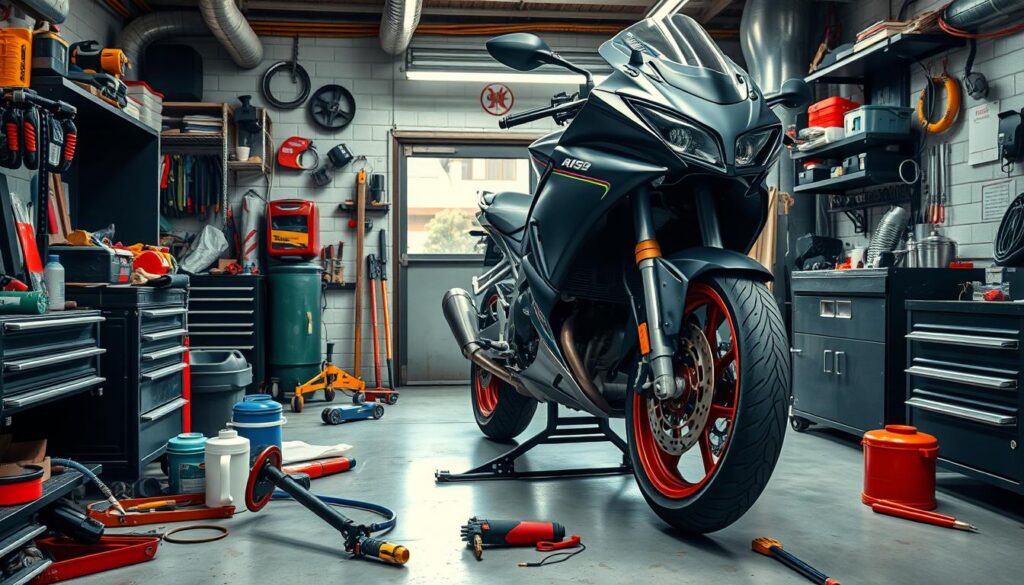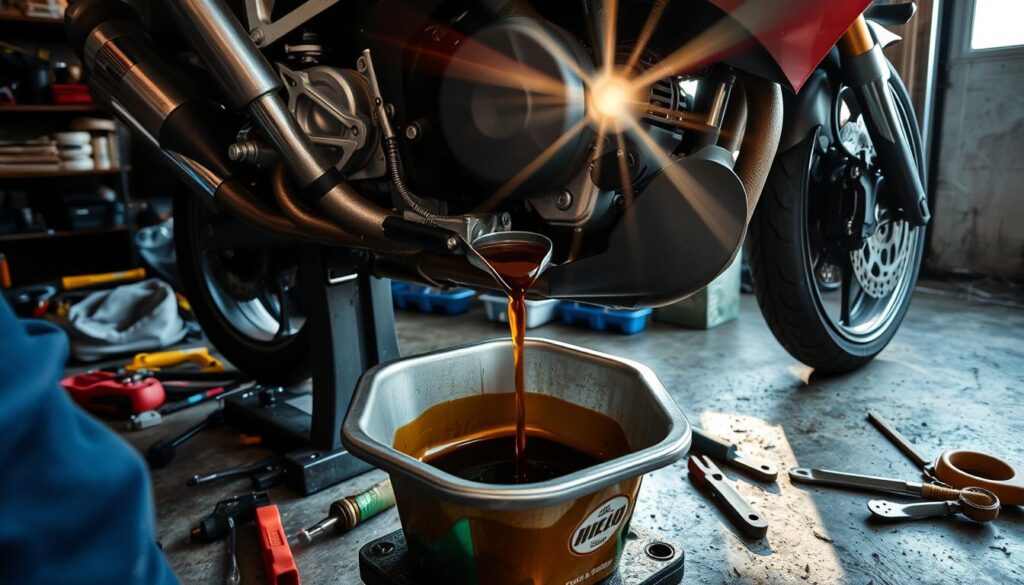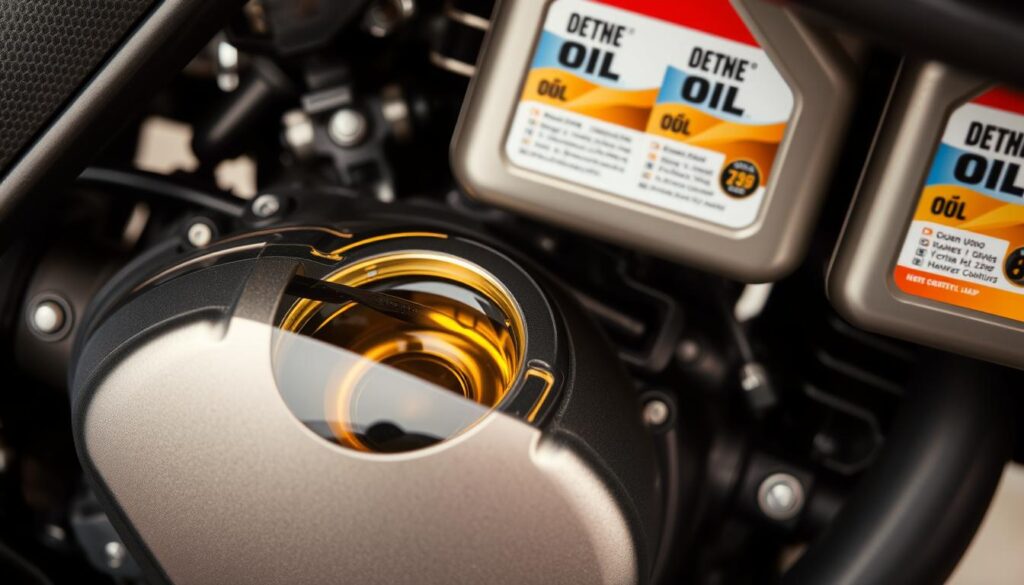As a passionate motorcyclist, I love hitting the open road. Feeling the wind in my face and carving through turns is exhilarating. But, regular oil changes are key to keeping your bike running smoothly.
Your motorcycle’s engine is its heart. Keeping it well-oiled is crucial for its performance and life span.
In this guide, we’ll explore motorcycle oil changes in detail. You’ll learn how to maintain your bike like a pro. This guide is for all riders, whether you’re experienced or just starting out.
By following this step-by-step guide, you’ll be able to keep your motorcycle healthy. Plus, you’ll save money on maintenance.
In This Guide

Understanding Motorcycle Oil Basics
As a motorcycle owner, knowing about motor oil basics is key. It helps keep your bike running well and lasts longer. Motor oil cuts down on friction, wear, and heat when your bike is moving.
Different Types of Motorcycle Oil
There are many kinds of motorcycle oils out there. Each is made for different engines and riding styles. You’ll find conventional, synthetic, and semi-synthetic oils, each with its own benefits.
Oil Viscosity Ratings Explained
The oil’s viscosity is shown by numbers like 10W-40 or 20W-50. The first number is how well the oil flows in cold weather. The second number is its thickness when it’s warm. Picking the right viscosity is key for your bike’s engine lubrication and performance.
Synthetic vs. Conventional Oil Benefits
- Synthetic oils offer top-notch motor oil replacement performance. They resist oxidation, thermal breakdown, and sludge better.
- Conventional oils are cheaper but don’t protect as well as synthetic oils.
- Choosing between synthetic and conventional oil depends on your bike, riding, and what you prefer.
Grasping these basic oil concepts helps you make better choices for your bike. It ensures a smooth and reliable ride.
Essential Tools and Materials Needed
Changing your motorcycle’s oil is key for auto maintenance and vehicle service. Before starting, make sure you have all the right tools and materials. This will help you change the oil easily and efficiently. Here’s a list of what you’ll need.
You’ll first need the right wrenches and sockets for the oil drain plug and filter. The size might vary based on your motorcycle’s make and model. Always check your owner’s manual or search online for the correct size.
- Wrenches and sockets (appropriate size for your motorcycle)
- Oil filter wrench
- Oil drain pan or container
- Funnel
- Clean rags or paper towels
- Gloves (optional, but recommended for cleanliness)
- New engine oil (check your owner’s manual for the recommended type and quantity)
- New oil filter
It’s also crucial to have the right motorcycle oil ready. Check your owner’s manual or talk to a vehicle service expert. They can tell you the best oil viscosity and amount for your bike.
| Tool or Material | Purpose |
|---|---|
| Wrenches and sockets | To remove the oil drain plug and oil filter |
| Oil filter wrench | To remove the old oil filter |
| Oil drain pan | To catch the used oil during the draining process |
| Funnel | To pour the new oil into the engine |
| Clean rags or paper towels | To wipe up any spills or drips during the oil change |
| Gloves (optional) | To keep your hands clean and protected |
| New engine oil | The fresh oil to be added to the engine |
| New oil filter | To replace the old, used filter |
Having these tools and materials ready will make changing your motorcycle’s oil easy and successful.
When to Change Your Motorcycle Oil
Keeping your motorcycle in top shape is key. Changing the oil at the right time is crucial. Knowing when to do it helps keep your engine running smoothly.
Mileage Recommendations
Most bikes need oil changes every 3,000 to 5,000 miles. Or, every 6-12 months. Always check your owner’s manual for your bike’s specific needs. Some oils can go up to 7,500 miles before needing a change.
Visual and Performance Indicators
- Regularly check the oil level and color.
- If the oil looks dark, thick, or gritty, it’s time for a change.
- Watch for signs like poor acceleration, low fuel efficiency, or strange noises. These could mean it’s time for an oil change.
Seasonal Considerations
Season changes can affect your oil’s condition. In winter, oil gets thicker and less effective. In summer, it thins out. Changing your oil before and after these changes helps your bike run well all year.
| Oil Change Interval | Mileage Recommendation | Seasonal Considerations |
|---|---|---|
| Conventional Oil | 3,000 – 5,000 miles | Check oil more frequently during extreme temperature changes |
| Synthetic Oil | 5,000 – 7,500 miles | Synthetic oil maintains its viscosity better in extreme temperatures |
“Regular oil changes are one of the most important preventive maintenance tasks for any motorcycle. Staying on top of this simple but crucial step can greatly extend the life of your engine.”
Knowing when to change your motorcycle’s oil is vital. It keeps your engine well-lubricated and protected. This helps your bike perform better and last longer. Remember, preventive maintenance and automotive care are essential for a well-running motorcycle.
Safety Precautions Before Starting
Before starting the motorcycle oil change, safety is key. Getting ready and taking precautions can avoid accidents. This makes the auto maintenance process smoother and more successful.
First, make sure your motorcycle is on a level, stable surface. This prevents it from tipping over. Let the engine cool down completely before you start. Hot surfaces and fluids can burn you.
Wear protective gear like gloves, safety glasses, and coveralls. This protects you from spills or splashes.
- Ensure the motorcycle is parked on a level, stable surface
- Allow the engine to cool completely before starting the oil change
- Wear personal protective equipment (PPE) like gloves, safety glasses, and coveralls
Also, have all the tools and materials ready. This keeps things organized and avoids interruptions. By following these steps, you can keep yourself and your vehicle safe. This leads to a successful and worry-free vehicle service experience.
“Safety should always be the top priority when working on your motorcycle. Taking the time to prepare properly can prevent injuries and ensure a smooth oil change process.”
Locating Oil Drain Points and Filters
Starting a motorcycle oil change means finding the right parts. You need to know where the oil drain plug and filter access points are. This knowledge is key for a smooth and quick oil change.
Common Drain Plug Locations
The oil drain plug is usually at the engine or transmission’s bottom. Its spot can vary, like the front, rear, or side. Always check your motorcycle’s manual or look online to find the exact spot for your model.
Oil Filter Access Points
Finding the oil filter can be tricky, as its spot changes with each bike model. It might be in the engine area, near the front or back, or under the seat. Look closely at your bike and use the manual to find the oil filter’s spot.
Gasket and Seal Locations
You also need to find gaskets or seals to replace during the oil change. They’re around the drain plug, filter housing, or engine areas. Replacing them helps avoid leaks and ensures a tight seal.
Knowing the parts involved in a motorcycle oil change makes you ready to do it well. Always check your manual and research your bike model for a safe and successful oil change.
How to Change Motorcycle Oil
Changing your motorcycle’s oil is key to keeping it running well. It’s important for both new and experienced riders. This guide will help you change your motorcycle’s oil easily.
Gather the Necessary Tools
First, make sure you have everything you need. You’ll need:
- Motorcycle-specific motor oil (check your owner’s manual for the right type and amount)
- Oil filter
- Oil drain pan
- Wrenches or socket set
- Shop rags or absorbent material
Drain the Old Oil
Place your motorcycle on a level surface and warm up the engine. Find the oil drain plug, usually at the bottom of the engine or oil tank. Put the drain pan under it. Use the right wrench or socket to remove the plug and let the old motor oil drain.
Replace the Oil Filter
After the old oil drains, find the oil filter. It’s usually on the side or bottom of the engine. Use an oil filter wrench to take off the old filter. Put a thin layer of new motor oil on the gasket of the new filter. Then, screw it on by hand until it’s tight.
Refill with New Oil
Put the drain plug back and make sure it’s tight. Then, find the oil fill cap and add the right amount of new motor oil. Check your owner’s manual for how much you need.
Start the engine and let it run for a few minutes. Then, check the oil level. Add more oil if needed to reach the full mark on the dipstick.

By following these steps, you can do a successful oil change on your motorcycle. Remember to throw away the old oil and filter properly. Enjoy the feeling of having a well-maintained bike.
Proper Oil Filter Replacement Techniques
Replacing your motorcycle’s oil filter correctly is key for good auto maintenance and vehicle service. If you don’t do it right, you might face leaks, poor engine performance, or even serious damage. Here’s how to replace the oil filter smoothly and effectively.
Filter Removal Methods
Finding the oil filter depends on your motorcycle model. It’s usually near the engine or oil pan. Start by finding the filter. Use the right filter wrench to loosen and take off the old one.
If it’s stuck, try using penetrating oil first. Let it soak in before you try again.
New Filter Installation Tips
Before putting on the new filter, clean the area where it will sit. This removes old gasket material. Then, put a thin layer of oil on the new filter’s gasket. Hand-tighten the filter until it’s snug.
Next, use the filter wrench to tighten it another 3/4 to 1 turn. Be careful not to over-tighten, as it can harm the filter or the mounting surface. After installation, check for leaks and make sure it’s securely in place.
| Filter Removal | New Filter Installation |
|---|---|
| Locate the filter Use the appropriate filter wrench Apply penetrating oil if stuck | Clean the mounting surface Apply fresh oil to the gasket Thread on by hand until snug Tighten with wrench 3/4 to 1 turn Check for leaks and secure filter |
By using these steps for oil filter replacement, you’ll keep your motorcycle’s auto maintenance and vehicle service up to par. This protects your engine and keeps it running well.
Adding the Right Amount of Oil
Finding the right amount of oil is key for your motorcycle’s engine. It needs the right engine lubrication to work well. The amount needed varies by motorcycle model. Always check your owner’s manual or the manufacturer’s advice for the proper oil viscosity and amount.
After draining the old oil and changing the filter, it’s time to add new oil. Pour it into the fill point, usually at the engine’s top or in a special oil reservoir. Be careful not to put too much oil. This can cause leaks or too much pressure in the engine.
- Look in your owner’s manual for the oil capacity for your motorcycle.
- Pour the new oil slowly into the fill point, checking the dipstick often to avoid overfilling.
- Stop adding oil when the level hits the “full” mark on the dipstick, then put the fill cap back on.
After adding oil, start the engine and let it run for a few minutes. This lets the oil spread through the engine. Then, check the oil level again and add more if needed to keep it at the right level.

It’s important to check and keep the proper oil viscosity and level often. Following the manufacturer’s instructions and adding the correct amount of oil helps your motorcycle’s engine stay healthy and perform well. This way, your motorcycle’s engine will run smoothly for many years.
Common Mistakes to Avoid
Changing your motorcycle’s oil is a key task. It’s not something to take lightly. Even experienced riders can make mistakes. Knowing these common errors can help you do a successful oil change.
Overfilling Risks
One big mistake is overfilling the oil reservoir. Too much oil can harm your bike’s fuel efficiency and engine. Always check the dipstick and follow the recommended oil amount.
Filter Installation Errors
Installing the oil filter wrong is another common mistake. If it’s not tightened right or if the gasket isn’t oiled, you might get leaks. Make sure to install the filter correctly and securely.
Oil Type Misconceptions
Using the wrong oil can also cause problems. The wrong oil can lead to engine issues and wear. Always check your owner’s manual for the right oil type and viscosity for your bike.
FAQ
What types of motorcycle oil are available?
You can choose from synthetic, semi-synthetic, and conventional motorcycle oils. Each type offers different benefits like better performance and engine protection.
How do I determine the right oil viscosity for my motorcycle?
Check your owner’s manual or ask a professional to find the right oil viscosity. Engine size, temperature, and riding conditions matter.
What tools and materials do I need to change my motorcycle’s oil?
You’ll need a drain pan, wrenches, an oil filter, new oil, and rags or paper towels. Have everything ready before you start.
How often should I change my motorcycle’s oil?
Oil change frequency depends on your bike’s make, model, and how you use it. Most say every 3,000 to 6,000 miles or once a year. But, also watch for signs that it’s time for a change.
What safety precautions should I take when changing my motorcycle’s oil?
Make sure your bike is stable, the engine is cool, and you’re wearing gloves and eye protection. Safety is key to avoid injuries and a successful oil change.
How do I locate the oil drain plug and filter on my motorcycle?
The locations vary by model. Check your manual or research to find where they are. This makes the oil change easier.
What’s the proper way to change my motorcycle’s oil?
First, drain the old oil. Then, replace the oil filter and add new oil. Follow your manual or a detailed guide for a complete change.
How do I properly replace the oil filter on my motorcycle?
Remove the old filter carefully and install a new one. Use the right tool, apply oil to the gasket, and tighten as directed.
How much oil should I add to my motorcycle’s engine?
The amount is in your manual or from the manufacturer. Too much oil is bad, so add just the right amount and check the level.
What common mistakes should I avoid when changing my motorcycle’s oil?
Don’t overfill, install the oil filter wrong, or use the wrong oil. Know the common mistakes to avoid a bad oil change.

